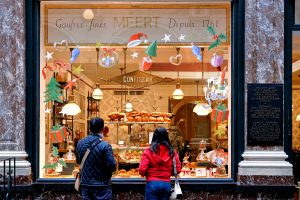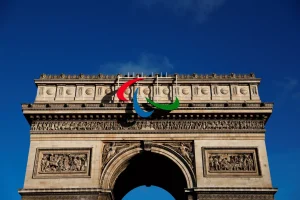During the weekend, from 1859 through to 1968, Parisians would get out of the city and head for Joinville-le-Pont or Nogent. These proto-holidaymakers would set off on Sundays to slake their thirst with glasses of ‘guinguet’, an unsophisticated, rather tart white wine common during that time, whilst watching beautiful women dance in between water jousting sessions. From this word we get ‘Guinguette’, the name for an open-air café or dance hall particularly associated with this period. Come with us, we’ll show you the way!

Starting point: Station n°43401 n°41301 Bois de Vincennes
Finishing point: Station n°43401 Gare RER – Canadiens
Journey time: 2 hours
Pavillon Baltard – a 21st century guinguette!
We begin this itinerary in front of pavillon n°8, one of the last great arched iron-work constructions designed by the eminent French architect Victor Baltard, “Vulcan’s lacework” as the poet Verlaine described it.
This pavilion and the treasures it contains have stood on the former site of Charles V’s ‘Château de Beauté’ since 1976.
One of the architectural and artistic feats of the 19th century was to design purely functional buildings out of iron in such a way as to rival the stone-built royal palaces of old in terms of aesthetics!
Nowadays, most of the guinguettes have been replaced by handsome mansions and other residential buildings. However, pavillon n°8 remains the most modern guinguette on the banks of the Marne…

Nogent-sur-Marne marina; Passerelle des Arts and Viaduc de Nogent
Once you reach the banks of the Marne, at the foot of the hill you can admire the old beach of the Maison Convert, one of the largest guinguettes in the area. Here, people enjoyed fried whitebait or fish stew before a swim, a game of skittles or a good-natured trip in a rowing boat! The French Rowing Federation now uses the remaining buildings and you can enjoy the spectacle of oarsmen and women training from the other bank!
Perhaps you feel this beach is rather small? Well, think again, my hearties… Nogent sur Marne’s marina is the second-largest river port in the Ile-de-France region, after that of l’Arsenal in Paris!
You’ll also come across four arches from Paris’ old Pont des Arts incorporated into a footbridge. For the last 29 years they’ve acted as a backdrop to the théâtre d’eau Charles Trenet, an open-air theatre by the water. NB : Charles Trenet is a famous French singer.
Between the fun of the guinguettes, water-borne tournaments and the river itself, it’s easy to understand why Marcel Carné shot his documentary film ‘Nogent, l’Eldorado du Dimanche’ (Golden Sundays) here!


lle des Loups and Ile d’Amour – a somewhat naughty haven of peace and quiet
Let’s cycle past these two memorably-named islands, the island of the wolves and the island of love…
Just 800 metres long, l’île des Loups (the island of the wolves) was indeed once home to females of a dangerous kind. A brothel on the island was named after Briseis, Achilles’ mistress. Their male clients probably headed here for some fun after having given their bodies a work-out at one of the sports clubs associated with the Société d’Encouragement des Sports Nautiques (Encou – an organization which promoted water-borne sports and activities).
Stars of the big screen like Charles Vanel, Marcel Carné and Marlène Dietrich also spent some time on this island.
If you want to visit these historic islands, rich in the memories of yesteryear, then you’d better roll up your sleeves, shipmates, as access is only possible by rowing boat!
Place Daguerre and the diorama theatre of the church of Saint-Gervais-Saint-Protais – the forerunner of modern cinema
So, what exactly is a diorama theatre? Well, it’s an early example of illusion as entertainment. If you cross over the bridge, you’ll find the last remaining intact diorama theatre in the world, right here in the town of Bry-sur-Marne. The diorama’s trompe-l’œil screen was created by Louis Daguerre to produce the illusion that the small church of Bry-sur-Marne was in fact a huge Gothic cathedral! Its creator is commemorated by a statue on Place Daguerre on the other side of the bridge.

Chez Gégène – keeping a folk tradition alive
Chez Gégène was the place to be seen. Now, it helps the guinguette tradition to live on! People danced the jig here on the River Marne during the Great War, before the original barge was replaced by a caravan in the Roaring Twenties.
Eugène Favreux, the famous ‘Gégène’, took over the reins and introduced numerous activities (bowls, swings, a giant boxer in the garden) to attract a regular clientele. However, the highlight of the spectacle had to be his camel…
In 1953, the song “À Joinville-le-Pont pon pon” was all the rage, an ode to the tradition of the open-air ‘bal musette’ dance accompanied by accordion music. ‘Gégène’ found its way into the lyrics…
Its fame as a venue was such that it served as a TV set for the first outside broadcasts on the one and only television channel that existed at that time. All the big stars, from Jean Gabin to Jean-Louis Trintignant and Doisneau, paid homage to Chez Gégène. Now it’s your turn!

Canal de Polangis, Ile Fanac – real pioneers!
In 1860, Julien, an everyday guy from Bercy, smelt an opportunity to strike it rich by adding a dance-floor to his new restaurant, whilst also using water-based leisure activities and the island of the Île Fanac to attract custom. The inhabitants of le Marais, at that time an industrial, working-class area, were delighted at what was for them an exciting trip from Bastille to Joinville-le-Pont. Today, the island is a sleepy place, so why not read “Au Bonheur des Dames” to help you get a real flavour of what it would have been like in those heady, hedonistic days. Emile Zola used Chez Julien as the inspiration for one of the settings of his novel.
Proof, if proof were needed, of the popularity of this area, the canal de Polangis just after Chez Gégène was constructed in 1886 with the sole goal of enabling people to enjoy a little rowing.
Ile Fanac is the big sister of l’île des Loups. It was here that the first rowing club on the Marne River was set up in 1883! The building you can see from the small bridge over the canal de Polangis is an identical copy of the 1883 building, which burnt down a few years ago. To get to the island, there’s a lift and a set of stairs on the pont de Joinville bridge itself.

Station n°43402 – Place de Verdun
Joinville-le-Pont marina and old Pathé factory – a hub for the silver screen and entertainment in general
This is the last stage in our itinerary. Here you can still see row upon row of wide roofs and the chimney stack from the old Pathé factory. You’ll start to have an idea of just how many workers would have flocked to the dozens of guinguettes and the Marne’s riverside beaches.
This is the birthplace of the French film industry, which can be traced directly back to Daguerre, the creator of the forerunner to the cinema. The company Pathé Frères was founded in 1886 in Vincennes. Very swiftly, the film production business became firmly established here, from the actual manufacturing of movie film to the showing of the end product recorded on that film, not forgetting research and development and studio film production and making.
The film studios in Joinville, Saint-Maurice and Bry constitute this cinematic hub. From “A very long engagement” (2004) to “Hunger Games: Mockingjay” (2014), there’s something for everyone! Between 1910 and 1970, 40% of all French-produced films were made at Joinville. It just goes to show that the ‘silver screen’ was a major player in the ‘Golden Age’ of riverbank society on the Marne – maybe that’s why it’s still referred to as ‘Eldorado du dimanche’…



